Final report for SW14-014
Project Information
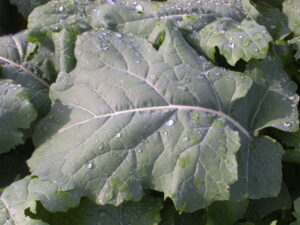 Winter canola grown at Ted Durfey farms near Sunnyside, WA. This was taken just before the October harvest for the dual-purpose system evaluated for winter canola.
Winter canola grown at Ted Durfey farms near Sunnyside, WA. This was taken just before the October harvest for the dual-purpose system evaluated for winter canola.
This project is aimed at evaluating, in the Northwestern United States region, the agro-environmental potential of intensive sustainable farming practices while diversifying crop rotations in the PNW region. Crop rotations were based on initial comparison of spring pea vs fallow followed by winter canola comparing single and dual-purpose canola, with winter wheat completing a single cycle. Two cycles were grown under irrigation in Montana and Washington. In Montana the on-farm study was grown rain-fed near Havre while the irrigated studies were grown on-station at the Northern Agriculture Research Center (NARC) at Havre and at the Western Triangle Agriculture Research Center (WTARC) at Conrad. The on-farm study in Montana was hosted by collaborating producer Jeff Hockett. Mr. Hockett’s was grown rain-fed about four miles from the NARC near Havre. In Washington, both the on-station study at the Irrigated Agriculture Research and Extension Center (IAREC) at Prosser and on-farm study with Ted Durfey at Natural Selection Farms, about 20 miles from Prosser, hosting and collaborating, were both grown under irrigation. In Idaho at the Parma Research and Extension Center, the project was initiated but due to planting restrictions imposed on the majority of southern and central Idaho for canola due to concerns of cross-pollination with the mustard seed industry (a widely grown high-value crop in the area), the decision has been made to switch from canola to mustard in Idaho. Field implementation of the project in the state of Oregon was scheduled to start in the spring 2016. The design and concept of this project was very innovative from the original PI, Dr. Kefyalew (Kefy) Desta when he was associated with Washington State University at Prosser. Dr. Desta relocated to Montana State University at Havre NARC in 2014/2015 with Dr. Roper, Director of Western SARE at the time, permitting the transfer of this project from WSU to MSU.
The first team meeting was hosted at IAREC at Prosser on September 8, 2015. All team members except for one from Oregon State University at Pendleton, OR, were in attendance. Dr. Desta led a fulfilling discussion of the project and his visions. Then Kefy informed team members he was leaving MSU for other opportunities but had a decided on replacement PI, Dr. Roger Ondoua from MSU at the WTARC from Conrad. Dr. Ondoua took the PI role and the next team meeting was also hosted at IAREC in Prosser on March 22, 2016. The project was approaching the halfway point in cycle 1 with cycle 2 initiated the following month. Dr. Ondoua left MSU in 2017 and was no longer PI on this project. Dr. Darrin Boss from NARC at Havre became the new PI. At the next face-to-face team meeting, held at IAREC at Prosser on March 16, 2017 with only a few members present Dr. Boss asked Dr. Steve Fransen to become a Co-PI on the project, which he accepted. The final team meeting was by conference call on March 20, 2018 to discuss development of the final report.
The project has been progressing through the different sustainable cropping rotations since its inception. The questions asked by the initial project team members were insightful and focused on investigating a new sustainable, biennial canola cropping system rotation for the PNW. There has been a large change in project team members with several current team members were not part of the original submitted and funded project. These new PIs do however think the project was of value, the objectives were ambitious and with a strong design and incorporation of such a research project on-farm is very challenging. The good news many of the original objectives can be addressed, some objectives were eliminated after team discussions, and some objective may never be answered. The educational benefit potentials are untapped but will require time for acceptance and adoption into sustainable modern agro-ecosystem canola rotation management.
Detailed results will be discussed within appropriate sections of this final report. The same experimental design was used in the three states, MT, WA and ID. Oregon decided not to participate in the project. For locations the same plot plan was used following a 2 X 2 X 7 factorial arrangement of treatments with four replications. The main factor were cropping system comparison of spring peas vs fallow, the second factor was winter canola planted following peas or fallow for single (grain only or biofuel) and dual purpose as fall grazed or simulated grazing of forage followed by grain for biofuel. The final factor were organic and inorganic soil fertility treatments. Using the correct expected mean squares the denominator was determined to test specific main or factor effects or interactions. Winter canola has not been a traditional grain or forage crop in Montana. In WA and ID winter canola is widely grown on thousands of rain-fed acres annually but only for the single purpose of grain for oil or biofuel. Expanding winter canola into the irrigated region and determining the dual-purpose potential of biennial winter canola could provide badly needed grazeable forage when pasture resources are normally depleted, plus providing essential grain for human oil consumption or energy for biofuel. The final phase of the production rotation cycle is winter wheat following winter canola grain harvest, using a wheat variety adapted to each of the three different locations, to act as a catch crop measuring soil nutrient balance compared to the initial soil samples through the multi-crop rotation over each production cycle.
Researchers in Montana hosted two field days during the course of this project where this study was highlighted and shown to area producers. From all indications there is interest among the farming community but a wait-and-see attitude likely best describes the response from many cautious ag producers when introducing new concepts and challenging long-held traditional values. Overall results suggest differences were often found when peas were grown as a nitrogen fixing cover crop compared to fallow and these differences were often prolonged through canola production but then lost by the end of the cycle. Some locations did find differences in canola grain production comparing single and dual-purpose management but these differences were often very small. Thus, the opportunity for incorporating the dual-purpose management may provide new opportunities to growers in Montana and Washington when raising winter canola for grain oil only. The following figures and tables are shared from results from the locations within the three states where this project was conducted. These provide a visual summary of various activities conducted as the project progressed since 2014 to date in 2018. As mentioned previously, the project was massive and complex and continues today until the final phase of cycle 2 is completed. The focus of this final report is devoted to the title of the project Sustainable Cropping Systems for Dual-Purpose Biennial Canola adaption and response to pea vs fallow before growing the crop and response to utilization as forage and nutrient treatment responses. 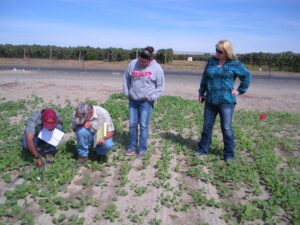
First team meeting on September 8, 2015 at Prosser, WA. Dr. Kefy Desta (with red cap) lead the discussion. Dr; Olga Walsh is standing on the right.
Quantify the fertilizer nitrogen requirements of biennial canola/mustard under the double-cropping scenarios using organic and inorganic fertilizer sources.
Quantify the nitrogen contribution of green pea to the succeeding dual-purpose biennial canola/mustard and winter wheat.
Assess the forage, silage, and hay quality of the canola grown after a fallow or a green pea crop.
Assess oil quality of biennial canola double-cropped with peas.
Compare the winter survival of canola under single and dual-purpose systems. This objective addresses the question of whether cutting canola in the fall affects winter survival and thus the final oil yield of the dual-purpose crop.
Conduct outreach on the studied cropping systems to increase the awareness of growers and the agricultural industry. Output: organized field days, workshops, and one-to-one meetings with target groups. Hardcopy publications, online, multimedia, and other outreach productions.
Cooperators
- - Producer
- - Producer
Research
Our hypothesis of this project was to introduce and develop new designer-type rotation with winter canola for single and dual-purpose benefits in the PNW. To test this hypothesis our team planted winter canola following spring peas or traditional summer fallow then harvested the canola as forage or grazed by livestock. The final phase of the cycle was winter wheat planted as a catch crop. This cycle was repeated twice in MT and WA. On-farm studies were conducted with the most successful at Ted Durfey farms near Sunnyside, WA.
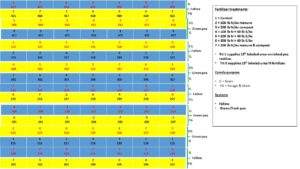
This figures shows the experimental arrangement of the study at all locations, both on-farm and on-station.
A complete discussion of the materials and methods have been described in the project reports submitted to date. Analysis of results were conducted using SAS where the denominator was determined from the proper expected mean squares to test the numerator of interest. Means were separated using LSD after a significant F test.
This project introduces potentially new sustainable ecosystem crop rotation into the PNW that could provide supplemental grazeable forage from winter canola in the fall when rangelands and pastures lands are in deficient production. To increase diversity of the rotation and provide an alternative to traditional fallow before establishing biennial winter canola, spring peas were introduced as an emerging crop in MT for nitrogen fixation plus a new marketable crop enterprise.
The Montana on-farm research study was conducted under rain-fed conditions, only four miles from the Havre station. The crop did establish in early August, produced a stand and was grazed by the owners’ herd of cattle. Unfortunately, the cattle largely overgrazed the study, since there was likely little else to consume at the time. The crop did not survive the winter and so the location was abandoned from further investigations. This study did provide one answer to investigators, that winter canola could be established in MT under rain-fed conditions but care must be exercised in post-establishment management and utilization.
The on-station study at NARC station at Havre was established in late July under irrigation and was properly grazed by cattle a few months later. This grazing success was helpful for the investigators to observe and provide some important results that dual-purpose canola management could be possible with animal husbandry management. The canola grain yield performance at NARC was excellent, table 1 for the harvest year in 2016. No advantage in canola grain yield was found when canola followed spring peas compared to traditional fallow. However, there was an increase in canola grain yield from the dual-purpose compared to the single purpose, grain only traditional management option. The dual-purpose management is a moving target with positive results some years and no differences other years. A nutrient fertility treatment response was found with the control significantly lower yielding that when organic or inorganic treatments were applied. These results support those of other studies indicating winter canola does not demand large quantities of nutrients but usually a little nitrogen is needed.
The two locations in WA were about 20 miles apart but the farmer, Ted Durfey with Natural Selection Farms, allowed the WSU personnel to largely control the land as they wanted. WSU prepared the soil, planted peas, canola and wheat with Mr. Durfey’s farm equipment. WSU also irrigated the fields for both cycles of production. The two cycles of production from the WSU on-station study, like those at Durfey farm, were conducted in very close proximity, essentially the same field. This segment of the canola cropping rotation was repeated over the course of three years for the two production cycles. Both locations largely experienced much of the same seasonal weather conductions over the course of the project. Because of the way the on-farm and on-station studies were conducted and agronomic timing was nearly identical, we analyzed the data not only independently for each location and year but combined locations by years and by years over locations. It is unusual to have these results but the generosity of Ted Durfey and Natural Selection Farms allowed this to occur. There were some location differences by treatments by year but the more interesting canola grain yield results are expressed in table 2 when locations were compared. There was a strong year effect at each location but the locations did not differ in canola grain yield responses within a year. These suggest, under rain-fed conditions where the need for occasional summer rain showers is removed through proper irrigation management that winter canola is well adapted under irrigation in the PNW. When comparing the influence of growing spring peas vs traditional summer fallow, there was a location by year interaction. The differences are found in the second year of canola production where yields are much lower than in the first year. Canola yields were lower for peas compared to fallow at both locations in the second year. We think this was a combination of excess winter kill of the canola stands over the winter of 2016/2017, table 3. During this winter period record accumulation of snowfall and days of snow cover were recorded in the Prosser/Sunnyside area. Actually most of eastern WA experienced a very harsh winter where many perennial agronomic and horticultural crop fields had to be replaced due to winter kill. Stand loss results in few productive plant and why canola grain yields were lower in 2017 than 2016 at both locations. One objective of interest was contribution of spring peas to soil nitrogen prior to establishment of winter canola. Table 4 presents results from cycle 1 at Prosser indicating soil nitrate increased by nearly four-fold after peas compared to before peas were grown. Soil organic matter also increased from pea root production and decomposition.
Table 1. Canola grain yield (kg/ha) and grain oil (%) content harvested from Havre, MT in 2016.
|
Treatment |
Yield Oil |
LSD (0.05) |
|
Previous crop pea |
2639.6 48.9 |
|
|
Previous crop fallow |
2692.3 47.9 |
NS grain : 0.47 oil |
|
|
|
|
|
Single purpose (grain only) |
2392.9 48.3 |
|
|
Dual purpose (forage + grain) |
2939.0 48.6 |
95.7 grain : NS oil |
|
|
|
|
|
Control |
2399.2 50.0 |
|
|
200 N from Manure |
2793.2 48.6 |
|
|
200 N from Compost |
2654.1 48.6 |
|
|
100 N from Manure + 100 N from compost |
2679.4 48.5 |
|
|
100 N inorganic |
2548.7 49.0 |
|
|
200 N inorganic |
2659.6 47.6 |
|
|
300 N inorganic |
2927.6 46.7 |
178.9 grain : 0.8 oil |
Table 2. Winter canola grain yield (kg/ha) at Durfey Natural Selection Farms and WSU-Prosser harvested in 2016 and 2017.
|
Treatment |
Durfey 2016 |
WSU 2016 |
Durfey 2017 |
WSU 2017 |
LSD by location X year |
|
Location X year |
2129.5 |
2012.0 |
1533.6 |
1489.5 |
NS |
|
|
|
|
|
|
|
|
Previous crop pea |
2246.6 |
1964.9 |
1484.3 |
1443.1 |
|
|
Previous crop fallow |
2012.5 |
2059.2 |
1583.0 |
1535.9 |
P< 0.0176 |
|
|
|
|
|
|
|
|
Single purpose (grain only) |
2312.4 |
2048.0 |
1559.1 |
1521.1 |
|
|
Dual purpose (forage + grain) |
1916.7 |
1976.1 |
1508.1 |
1457.8 |
P< 0.0273 |
|
|
|
|
|
|
|
|
Control |
1559.4 |
1635.1 |
1514.4 |
1170.0 |
|
|
200 N Manure |
2095.5 |
2029.2 |
1681.1 |
1697.7 |
|
|
200 N Compost |
2494.2 |
2114.2 |
1356.2 |
1454.0 |
|
|
100 N Manure + 100 N Compost |
2479.9 |
2059.7 |
1485.7 |
1446.0 |
|
|
100 N inorganic |
2000.8 |
2114.2 |
1565.3 |
1460.5 |
|
|
200 N inorganic |
2068.1 |
1868.7 |
1444.1 |
1645.2 |
|
|
300 N inorganic |
2211.7 |
2059.7 |
1688.7 |
1446.0 |
P<0.0383 |
Table 3. Winter canola stand plant population, plants / m2. Results are means of three subsamples collected per plot in the fall and then in the spring at Ted Durfey and WSU-Prosser over the winters of 2015/2016 and 2016/2017.
|
Comparison |
Canola stands |
LSD (0.05) |
|
Durfey Farms |
39.9 |
|
|
WSU-Prosser |
31.6 |
1.44 |
|
|
|
|
|
Fall count |
51.2 |
|
|
Spring count |
20.4 |
1.44 |
|
|
|
|
|
Single purpose (grain only) |
36.4 |
|
|
Dual-purpose (forage + grain) |
36.2 |
NS |
|
|
|
|
|
Cycle 1 |
39.3 |
|
|
Cycle 2 |
32.3 |
1.44 |
|
|
|
|
|
Previous pea crop |
33.8 |
|
|
Previous fallow |
37.7 |
1.44 |
|
|
|
|
|
Control |
38.0 |
|
|
200 N Manure |
35.9 |
|
|
200 N Compost |
38.1 |
|
|
100 N Manure + 100 N Compost |
34.4 |
|
|
100 N Inorganic |
35.1 |
|
|
200 N Inorganic |
33.2 |
|
|
300 N Inorganic |
35.6 |
2.73 |
Table 4. Comparison of soil at Prosser in 2015 before and after planting of peas or fallow and before planting of winter canola.
|
Comparison |
Soil nitrate (ppm) |
Soil Organic matter (5) |
LSD LSD Nitrate OM |
|
Before planting pea |
6.1 |
0.86 |
|
|
After planting peas |
26.0 |
1.15 |
6.0 0.06 |
|
|
|
|
|
|
1 foot depth |
19.9 |
1.89 |
|
|
2 foot depth |
19.7 |
0.89 |
|
|
3 foot depth |
11.4 |
0.70 |
|
|
4 foot depth |
10.9 |
0.51 |
2.0 2.0 |
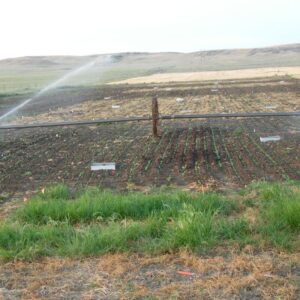
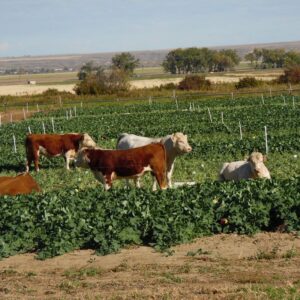
Western SARE study site and cattle grazing winter canola at Havre, MT NARC site in 2015.
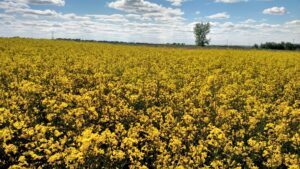
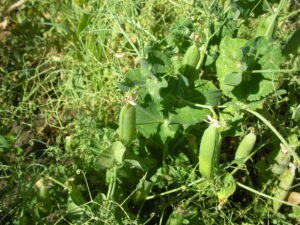
Full flower canola at Havre, MT in June 2016 and spring peas grown at Prosser, WA in 2016.
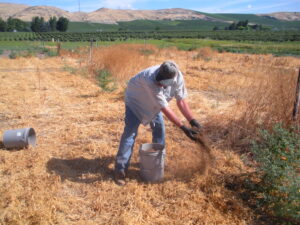
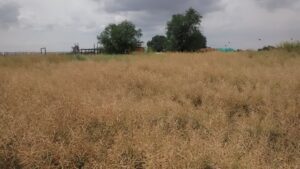
Application of organic nutrient treatments and canola crop ready
for harvest at Ted Durfey site at Sunnyside, WA in 2016 and 2017.
Impacts
The complete value and impacts of this project will be realized in the next 5 to 15 years. This timeline is about that required for any significant change to occur on targeted farms. Our target farm includes producers with investigative minds, those who like to add diversity to their farming operations, families who realize that holding fast to traditional commodity markets may not sustain their farming operations in the future and who want to pass the farm unit to the next generation. These farmers are more family farming operations, often more diversified with incorporation of livestock into the daily farming production system. They search for additional market outlets and working with or owning livestock opens new markets not provided by only producing a grain crop. Even an alternative oil-seed grain crop. Dual-purpose canola can provide that alternative crop into rotations through breaking disease and insect cycles, disrupt weed cycles, and increase soil improvement. When winter canola is used in a designer-type rotation, as was planned and conducted in this study, within about 30 months four potential crops can be grown and sold/utilized compared to traditionally two crops would be grown and marketed. This Sustainable Cropping Systems for Dual-Purpose Biennial Canola project has shown this can be accomplished plus do no more harm to the environment compared to traditional farming crop rotations.
This project should be viewed as laying the foundation for the future of more designer-type crop rotational systems where food and livestock crops not only co-exist but positively contribute to each other in sustainable means. The major crop being introduced is winter canola in regions where it may never have been grown or where it is demoted to a lesser value than other high valued crops. Winter canola has traditionally been used for a single purpose, production oil for both human consumption and oil for the biofuel industries. This project creates an in depth investigation into expanding the capabilities of winter canola as a forage crop for utilization in the fall and grain production the following summer. This should expand potential markets and increase demand of this valuable high oil bearing biennial crop.
Major conclusions learned from this project include but not limited to:
- Winter canola area of adaption is greater than first expected. We now know that canola will survive in Montana over winter, it can produce valuable forage in the fall that can be grazed directly or conserved. The crop will produce a harvestable oil seed grain the following year but success will likely only be found on irrigated lands rather than rain-fed ground. The potential is higher after this project for Montana growers to attempt to grow winter canola where they would have never considered this as possible before.
- Winter canola stands must be dense in the fall because more than 50% of stand loss can occur from winter kill. All farmers know every year will be different and stand density in winter canola maybe no different than winter wheat. In our study we did find differences in stand density with greater winter kill incidence when temperatures were lower than normal, and snowpack was deeper and longer than normal. This is similar to other agronomic crops who struggle with maintaining strong stands over harsh winter months. This has been suspected in the past but stand density counts have been inconsistent with many variable changing from farm to farm or canola variety and fertility. Stand density partially contributes to high grain yields in winter canola.
- Winter canola has tremendous plasticity and compensatory ability. This plasticity allows the crop to regrow rapidly after defoliation as forage and still recover before entering winter. This genetic variability also contributes.to the unpredictable impact on final grain yield from changes in single or dual-purpose management or soil nutrient management. Much more research needs to be conducted to refine recommendations to growers to better understand the changes in stressors on canola plant growth and development and sustainable grain production.
- Winter canola is a relatively low cost crop but the value of the grain, although very high for oil, does not replace the value of more traditional crop commodities. Costs are low but returns many also be even lower though demand for canola oil is very high. Better economic forecasts and enterprise budgets need to be targeted for development so potential can receive a fair market value for their production.
Accomplishments
Largely the funded objectives were addressed since funding in 2014/2015. Some objectives had to be eliminated due to changes in project focus and funding. This was a very ambitious project and very much underfunded for the stated goals and objectives. However, much has been learned and still there is more to learn since some field and laboratory aspects are not completed. The project team is committed to completing this over the next year then first organize and publish as a PNW Extension bulleton. After that is accomplished then manuscripts can be developed. Our goal is to get this information of PNW growers so they can start to comprehend how winter canola can be introduced into traditional crop rotational systems in the PNW. Once growers see the benefit then the true benefit of dual-purpose use, can be further realized.
Modifications or changes to the original objectives, with a discussion of what/why/how changes were made follows in bold:
Objectives are:
- Quantify the NPK requirements of biennial canola under double-cropped scenarios and using organic amendments as fertilizer sources
Output: Determined NPK requirement of double-cropped dual-purpose biennial canola cropping system
The focus of the project became nitrogen rather than P and K or micronutrients. Organic sources came from manure and compost compared to inorganic sources.
- Quantify the N contribution from green pea to succeeding dual-purpose biennial canola
Output: Estimated the N contribution of legume precursors crops such as green pea to succeeding biennial canola.
This was accomplished and compared to nitrogen mineralization from fallow, prior to incorporation of manure, compost or inorganic sources through monitoring soil changes before and after growth of peas and fallow. The plan also included using N15 grown pea forage to monitor nitrogen uptake. At WSU we grew multiple crops of N15 pea forage over two years in the Prosser greenhouse. This was shared with NARC and WTARC scientists and also used at Prosser plots. At the 2016 team meeting this phase of the project was discussed and eliminated as an objective.
- Assess the effect of adding canola hay to low quality corn stalk and wheat straw roughage to improve digestibility in cows. Assess the effect of green pea and fertility levels on hay quality of canola.
Output: Quantified feed quality of canola hay; evaluated digestibility of canola hay-roughage mixture.
The project team recognized the importance of evaluating the digestibility of canola forage by ruminants. The concept of producing wet canola forage (about 10% dry matter) into hay (90% dry matter) was unlikely in the very moist and cooler fall conditions. The alternative concept was to compare insitu digestibility of canola forage grown in the field studies by treatment. This was recently accomplished through insitu digestibility measurements from samples scanned through the WSU Prosser NIRS. These samples were selected by the NIRS program for further wet lab analysis insitu digestibility. The current equation now must be edited with the samples re-predicted to provide the final quality analysis of the dual-purpose component of winter canola.
- Assess oil quality of biennial canola double-cropped with green pea
Output: Compared oil yield and quality of dual-purpose and sole purpose biennial canola under double-crop systems.
This phase of the project is important and still needs to be completed. We have an equation for canola grain oil with most of the canola grain samples scanned and predicted. The more recent canola samples have not been scanned or predicted and will be over the next year. We expect, and the Montana results from NARC show that increasing nitrogen fertility will decrease grain oil seed content. How concentrations of oil change with locations, treatments and years is unknown.
- Compare the winter survival of canola under sole biofuel and dual-purpose systems. This objective addresses if cutting canola in fall affects winter survival and thus final oil yield as a dual-purpose crop
Output: Assessed winter damage/survival of dual-purpose and sole-purpose canola.
This objective has been completed. Winter survival of biennial canola is one of two weak links in its production cycle. The other is initial stand establishment. We monitored stand density in the fall and spring at two locations over two growth cycles. We found on average greater than a 50% stand loss due to winter kill in biennial canola. If stands are thin initially, this loss of density will impact final canola grain yield. This happened in our study during the winter of 2016/2017. Stands were adequate entering winter in 2016 but record breaking snowpack, duration of snow cover and winter temperatures greatly reduced canola stand density for both locations in WA. Winter canola possess high plant plasticity that allows for compensation when used as forage and also loss of stand density. When losses are too great for the crop to overcome then grain yields will decline, which they did.
Research Outcomes
Education and Outreach
Participation Summary:
Education and Outreach Outcomes
The future will determine how this investment will influence canola production and acceptance into new and designer-type rotations across the PNW. The potential is high but our goal is to reduce potentially high risks of growing and marketing multiple products from winter canola. Over the course of this project we have learned winter canola plasticity is robust allowing for dual-purpose use as forage plus grain yields of oil and protein rich seeds. This plasticity also increases the difficulty of accurately predicting if grain yields will be reduced when grazed or harvested a silage. Plasticity does allow for thinner stands, due to loss from winter kill, to still produce a harvestable canola grain crop. The benefits to farmers will, if adopted and managed successfully, meet the goals of WSARE for economic, environmental and social sustainability.
- None
None